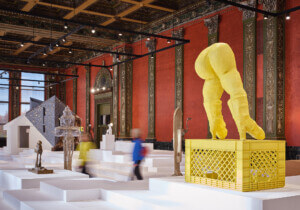At the Chicago Architecture Biennial, the role of the horizon in architectural display and setting for events was noticeable—both in the biennial’s discussions held at the Illinois Institute of Technology (IIT) Chicago during the opening as well in the main exhibition in the Chicago Cultural Center. Here is what made instant impressions. When the dust settles, various other things will emerge, that I am sure.
IIT threw a party for the biennial, as well as hosted panel discussions earlier that day. Without a doubt, Mies van der Rohe’s Crown Hall is an unbeatable example (on its ideological turf) of how rigorous rules of platonic geometry still drive the photogenic nature beyond actuality, and somehow end up being free of time. The Crown Hall is not only a setting of purity in Cartesian world of grids, but also an organizational force that persists as a monolith in face of any pluralistic trends of the moment, many of them that are present at the biennial.
Two discussions “crowned” the morning of that day. First, by reviewing a group of “Emerging Voices,” a descriptor meant for a youngish architecture practice established by The Architectural League of New York. After presentations by Dan Wood, Tatiana Bilbao, Michael Meredith, Florian Idenburg, Paul Lewis and Kim Yao, along with a Martin Felsen-moderated discussion, Anne Rieselbach, of the Architectural League, asked the question that was hanging in the air (paraphrased): For how long will emerging architects will still be considered emerging?
Judging by the work presented, the offices owned by the panelists are well ahead in their production of some very important projects. Yet, ideologically, what is the position of supporting institutions of Emerging Voices in order to understand the advance of such highly educated architect makers, influenced by being apprentices to their “parent” architects such as OMA, Peter Eisenman, Steven Holl, Diller Scofidio+Renfro, and SANAA. Are they, the “emerging children,” still struggling to assert their own brilliance and excellence already on record? The interesting and lateral voice was Tatiana Bilbao, architect from Mexico City and the only woman on the panel, for whom the question of influence nor mentorship really seemed to matter. It is always good for the debate to see someone shake the table horizontally and get the discussion to go further.
Bilbao is from what people in the North call the South. Which leads me to the observation of the second panel at IIT, moderated by Fabrizio Gallanti and titled “South-North,” as an inversion to common understanding of geography. This conversation involved two architects from the “South” and two architects from the “North.” Felipe Mesa and David Barragan, spoke about how different it is to be an architect from the south, and how the south is discovering new phenomena in the last five years, such as tourism. Architecture seems to play a large role in the trend of emerging tourism in locations that were not usually visited before.
The lessons from these conversations at this time seem two fold. At one end, the inclusion of the south is simply not just having south, it is about being south from the north. In terms of competence of design and construction process, there seems to be no difference, yet there is asymmetry due to different climates that impose legal regulations onto architecture. David Barragan from Quito referred to vernacular architecture in Ecuador as an escape from the curriculum of the architecture schools there that teach detail drawings made to Swiss and German standards, which no one can read and perform there. The case in point.
A side discussion with Paul Lewis unfolded at the scene after these two panels. We both looked at the ceiling of IIT covered in tiles that are in square shape while the entire geometry of the Crown Hall is rectangular. It is good to remember that ideas behind pure architecture are indeed purer in geometry, and not necessarily in economy.
Back at the Chicago Cultural Center, three installations stand out as direct answers to the title of the biennial: The State of the Art in Architecture. If not noted before, this title is borrowed from Stanley Tigerman’s conference held at Graham Foundation in 1977.
For me two projects presented at the biennial draw attention to this topic at best: First, Nikolaus Hirsch & Michel Müller and, second, WORKac & Ant Farm. They take the aspects of the future from the past seriously into the design process of crafting them now. It is a fantastical world of day-dreaming of architecture that crosses through any statements of architects trying to do art…and fail gracefully…into the next set of ideas of what the future of art shall be, by architecture.










